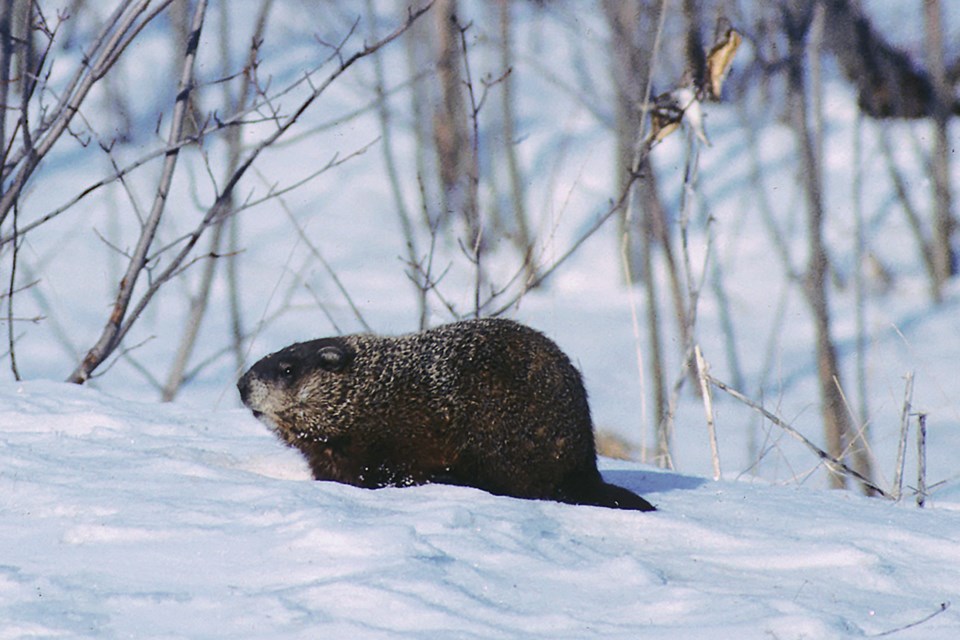As you may recall, oh dear and faithful reader, about a decade ago I proposed a halt to this silly thing called Groundhog Day. Rodent watching in mid-winter? Get real. The groundhogs are sleeping soundly and really don't wish to be disturbed until spring!
My flawless proposal of the day was to create a Snowy Owl Day and it has, I'm sure, been taken seriously by those authorities whose job it is to find good ideas and make them happen. No doubt they have a committee (maybe even two?) designing a promotional package to enlighten the rodent-weary masses as to the virtues of observing snowy owls in February.
Now wait a minute. Before you dismiss me as just another ranting curmudgeon who's fed up with winter, let me share an idea with you. Firstly, understand that I am in favour of most anything that promotes nature, and groundhogs certainly fall into this category. Secondly, it's nice to have some sort of celebration to disrupt the monotonous routine of putting on layer upon layer of clothes and then, sometimes just minutes later, taking off layer upon layer of clothes.
But wouldn't the celebration be a little more meaningful if it highlighted something special about winter? Do we have to use a creature that goes to sleep in October and doesn't show up again until March as the champion to see us through this last bout of snow and cold?
However, I must confess my puzzlement as to why I have not been asked to head up this Snowy Owl Day planning team; probably a committee oversight that will be rectified shortly. Sadly, due to the lateness of said committee's news release and subsequent press party, it appears that we are stuck with Groundhog Day (groan) for yet another year.
A bit of research (and I do mean 'a bit') has revealed that this current tradition originated in Europe — a place where our field-loving Marmota monax doesn't even exist! Over yonder they have hedgehogs and badgers, but how they became thought of as groundhogs is beyond me. A bit of European humour, I suppose.
Admittedly, the winters in central Europe tend to be a tad shorter than ours, and over there it is indeed possible to observe a few emerging burrow dwellers by early February. And who can deny the citizenry the flush of joy at seeing something that, at long last, resembles spring?
But not so in our part of the planet. Feb. 2 usually finds us with substantial amounts of snow still lying heavily upon the ground. If a groundhog did wake up and pop outside for a wee breath o' fresh air, it would find two things missing: food and a mate. Lacking both, or either, it is difficult to persuade a groggy groundhog to remain out of bed.
Give it a few weeks, and by maple sugaring time the fields will have become spotted with the muddy footprints of the early risers, their brownish trails radiating outward from the burrow entrance like spokes of a wheel.
These tracks indicate the travels of a hungry and mate-desperate animal. Males have been known to dig down to still sleeping females in attempts to roust them out of their winter dens. "z-z-z-z, huh, wha? Lemme sleep one more week, OK? Just one more week, z-z-z-z."
Last fall, when the groundhog started into this deep sleep, its entire body had to slow down in order to conserve energy. The fat layer obtained from the bounty of autumn foods had to sustain the critter for four to six months. In its hibernating state, the animal's heart rate dropped from 80 beats to four per minute, and it took only one breath every five minutes. Can you do that? OK, but can you wake up afterward? Uh-huh, didn't think so.
Among the many wonders of this new century, research is providing the answers to the mystery of hibernation. By applying some of this knowledge toward people, there have been surgical operations performed with a person's heartbeat and breathing lowered almost to a state of hibernation.
While it takes a while to reach these low levels of bodily function, animals can bounce back rather quickly. Once the warmth of springtime sunshine penetrates the soils, they wake up just in a matter of hours. However, they have lost 30 per cent of their body weight, so are a tad on the hungry side.
My, but how I've digressed from the point of this article, which was to dissuade you from taking part in what is obviously a cheap shot at finding something good about winter. There are enough real winter critters out there to champion (like the snowy owl, hint, hint), so why pick a sleepy, underweight, oversexed and scruffy rodent?
Oh well. Until next year (maybe), happy Groundhog Day!



